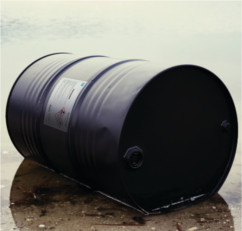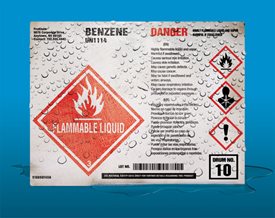Ensure the safety of your operation, employees and the environment. If your company produces, ships or uses chemicals or other hazardous materials, labels that comply with the OSHA-mandated Globally Harmonized System (GHS) are critical.
Help ensure your labels are GHS compliant. PPG TESLIN® label stock is specifically engineered to protect the printed data that keeps your operation safe and in compliance with GHS label requirements.
 What is the GHS?
What is the GHS?
Maximum Water and Abrasion Resistance
When chemicals and hazardous materials are shipped via international waters, they are required by the International Maritime Dangerous Goods (IMDG) Code to use BS 5609-certified pressure-sensitive adhesive labels.
To ensure BS 5609 compliance, you should select a high-quality GHS label stock that meets two key standards, namely:
Help ensure your labels are GHS compliant. PPG TESLIN® label stock is specifically engineered to protect the printed data that keeps your operation safe and in compliance with GHS label requirements.
 What is the GHS?
What is the GHS?
- The Globally Harmonized System (GHS) is a framework enacted by the United Nations to provide an internationally recognized system for identifying and communicating hazardous chemicals.
- This framework makes the handling and transport of chemicals safer for humans and the environment.
- The GHS mandates that chemical containers ranging from 55-gallon drums to spray bottles and even small vials must be in compliance.
- From industrial coatings, sealants and primers to solvent-based cleaners and degreasers, there are myriad chemical formulations that require GHS labels.
- GHS label compliance is dependent on the durability of the label, correct label content and effective document management.
- If dangerous or hazardous chemicals are transported via water or ocean vessel, the International Maritime Dangerous Goods (IMDG) code requires the GHS label to meet British Maritime Standards (BS 5609) certification.
Maximum Water and Abrasion Resistance
When chemicals and hazardous materials are shipped via international waters, they are required by the International Maritime Dangerous Goods (IMDG) Code to use BS 5609-certified pressure-sensitive adhesive labels.
To ensure BS 5609 compliance, you should select a high-quality GHS label stock that meets two key standards, namely:
- BS 5609 Section 2 – Optimal label performance
Blank labels are exposed to marine environments, temperature variations, weathering, salt spray and sunlight to determine the permanence and durability of the label material and adhesive. - BS 5609 Section 3 – Optimal print performance
The key difference in Section 3, as opposed to Section 2, is that Section 3 tests the printed label. For Section 3 compliance, labels are tested for print removal using adhesive tape, observing legibility after abrasion from sand and seawater and print permanence after exposure to sunlight and salt spray.

Label Requirements
What information do you need on the label? GHS-compliant labels use text and colored pictograms to communicate six essential pieces of data, including:
- Product identifier: The name of the enclosed chemical
- Hazard pictograms: The hazard associated with the chemical
- Signal word: “Warning” or “Danger,” depending on the severity of the chemical hazard
- Hazard and precautionary statement: physical, health and/or environmental hazard
- First aid statement: Emergency care instructions for those exposed to the chemical
- Contact information for the supplier or responsible party

